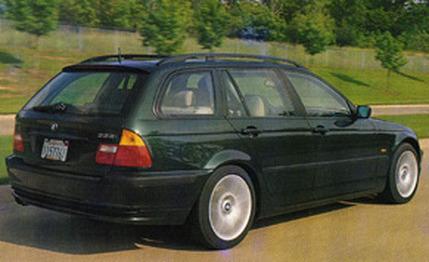
 Road Test
Road Test
You may have noticed that almost every station-wagon introduction in the past few years has inspired observations about wagons making a comeback. You may also have noticed that we've been just as guilty of these incorrect observations as others, and perhaps even more than most, since we think wagons make a lot more sense in most applications than do sport-utes. They're handier and better-looking, and they get better fuel economy—remember fuel economy? And they're more fun to drive.
However, the truth is that all this nattering about the wagon revival is distinctly parochial. Wagons may be an endangered species in the U.S., where we've been a little preoccupied with sport-utilities—per-haps you've noticed this?—but they've never faltered elsewhere, particularly in Europe, where wagons account for almost 50 percent of all auto sales, year in and year out. And even though European and Asian automakers limit the range of models exported to this country, there currently are 20 station-wagon nameplates sold here.
U.S. automakers, in contrast, offer five wagons—three from Ford (Focus, Taurus, and Sable), two from General Motors (the small Saturn and the slightly larger Saturn)—but none from DaimlerChrysler, although the PT Cruiser does fall into a sort of twilight zone.
None of these domestic offerings, we should add, approaches the panache and performance of our test subject. And after all, where does it say that the need for a little extra cargo capacity should automatically sentence one to understeer, wallow, and generally somnambulistic motoring?
Evidence of the ongoing international vitality of the wagon is BMW's new 323i. It's new only here in the U.S.; it was introduced in Europe about a year ago, the third renewal of a 3-series wagon tradition that dates to 1988. In fact, BMW claims to have pioneered the concept of a wagon in the sport-compact class.
Well, all that history probably won't move you one micron closer to a contract, right? So let's take a look at the tangibles.
Along with the convertible, the wagon represents the completion of the latest renewal of the regular 3-series lineup, a makeover that began with the rollout of the sedans for 1999. We're still waiting for the arrival of the M versions, of course, but the M3 ain't exactly mainstream goods. And we don't expect to see an M badge on a station wagon around here anytime soon.
The wagon shares the same chassis and body dimensions, with fractional distinctions, as the rest of the fleet. Ditto power-trains. Ditto, that is, everywhere but here. Although the 3-series wagon is offered in five configurations in Europe—318i, 320i, 328i, 320d, and 330d—U.S. buyers will have a choice of just one: the 323i, propelled by a 2.5-liter DOHC 24-valve in-line six.
We can understand BMW's holding back the lame-duck 2.8-liter six, but there are no plans to send us the new 3.0-liter, either. Why no 330i wagon? BMW cites "cost sensitivity" in this market segment, where the major competitors are the Audi A4 1.8 Avant Quattro and the Volvo V40, both of which have substantially lower base prices ($27,265 and $24,975, respectively). To illustrate the price point, today's 328i sedan has a base of $33,970, and that's $6410 north of a 323i's, or about $21.44 for each extra cubic centimeter of engine displacement, a pretty serious premium. However, BMW insiders also hint that the lively performance of a 330i wagon might very well damp the enthusiasm for the 540 wagon, since the minimum payout for the bigger car is $42,772.
Augmented by BMW's VANOS variable-valve-timing system, the 2.5 straight-six is smooth and has sweet torque traits, but even so, its 170-hp peak seems pallid compared with the 2.8-liter's 193. And it'll seem positively anemic when the 225-hp, 3.0-liter six comes on stream in 2001.
The 2.5-liter's relatively tame output is magnified by the one significant dimensional distinction between wagon and sedan, measurable at the scales. The last 323i sedan to pass our way (C/D, April 1999) weighed in at 3120 pounds, 236 pounds lighter than this wagon, a distinction attributable, as you'd expect, to the wagon's extra superstructure and the glass aft of the C-pillar.